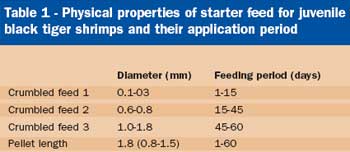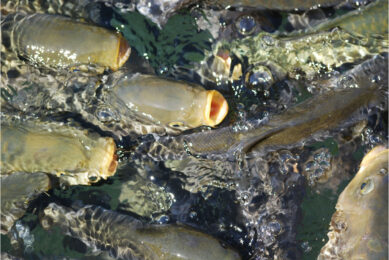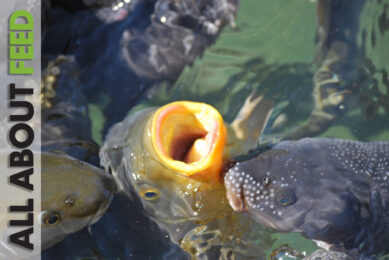A revolutionary concept for shrimp feeding

Shrimp feed accounts for the highest portion of the production cost of farming, and lack of understanding of shrimps’ eating behaviour makes feeding even more expensive. The present practice of feeding management in shrimp culture needs to be re-examined.
| J.W. Hertrampf, residing in Malaysia, is a regular contributor to our magazine on aquaculture subjects. P.K. Biswal is the manager and S.K. Mishra is senior executive of the R&D-Unit of The Waterbase Ltd., Nellore/India. Both have a M.Sc. in fish biology. |
During the culture period of shrimps, generally, different types of feed are used. They vary in their physical appearance and their sizes. It is very common that in shrimp farming at least three starter feeds and between two and three grower feeds are fed to the animals. In most cases starter feeds as well as grower feeds have identical nutritional values within the same starter/grower category. The only difference is the physical appearance in terms of pellet length and pellet or crumble diameter.
Earlier trials have demonstrated that neither the pellet length nor the pellet diameter have an impact on shrimps’ performances. Crumbled starter feed on the other hand, is a water pollutant and can be replaced successfully by pelleted starter feed.
Eating behaviour of shrimps
Lack of understanding of the eating behaviour has led to the wrong perception that shrimps are swallowing the feed like fish are doing. In this context Wankowski and Thorpe (1979) reported that the growth rate of Atlantic salmon (Salmo salar) was closely related to the particle size of the feed. Feed formulations were developed, based on certain bodily parameters of the fish, as e.g. the fork length of the fish, for determining the right pellet size. This means that the pellet size has to be adapted to the respective size of the fish. Although large fish can consume small particles, more energy is required to capture an equivalent weight of smaller particles with a consequent reduction in feed efficiency.
Due to this misconception on the eating behaviour of shrimp, this huge number of different feed types has evolved. The existing literature does not provide any information why shrimp feed has to be of different length and diameters. It can be, however, speculated that along the way some shrimp farmers have requested for shrimp feed in different sizes. But it is also possible that one or the other shrimp feedmill has created this differentiation. At a consequence of this wrong assessment feed manufacturers have adapted the production of different pellet/crumble sizes. And, therefore, the great number of shrimp feed types became a “must”, although an in-depth analysis of the need has never been conducted.
Considering that wild shrimps eat everything which attract them, irrespective of the size of the food item, whether it is big or small, the eating behaviour of shrimps has been studied. For the ingestion of food shrimps use their second pair of chelated legs for holding and cutting it with the mandibles. This means that the animals are nibbling on the food and not swallowing it.
As a consequence of this eating behaviour, shrimp feed must have a sufficient water durability (stability). Generally, the feed is consumed within two hours after application. However, it was found that 50% of the applied feed is consumed within 30 minutes.
Establishing the eating behaviour of shrimps has had the logical consequence to study whether the performances of shrimps will be affected negatively, if fed with one starter and one grower feed only instead of three starter and two grower feeds.
One starter feed contra three starter feeds
In a 60-days trial at the R&D Unit of The Waterbase Ltd, in Nellore, India, one group of juvenile tiger shrimps (Penaeus monodon) were fed with three crumbled starter feeds of different diameters while the other group was fed with one pelleted feed. The trial has been carried-out in six 150 litre aquaria with each group having three replicates. The physical properties of the feed and the respective feeding periods are in Table 1. The animals were fed four times a day and the daily feeding rate amounted to 10% of animals’ body weight.
From the early stage of the experiment, the pellet fed juvenile shrimps grew faster than the group fed with crumbles. This trend continued right through the entire trial period (Figure 1). After 60 days, the pellet group achieved a mean live weight gain of 3.78 g which is 20.4% statistically significant higher that that of the crumble group (Table 2). A statistically improved feed conversion rate or 22.0% is the result of feeding pellets instead of crumbles.
In a related study it was found that juvenile shrimps fed on pellets were more uniform than their counterparts fed on crumbles. This was concluded from the standard deviation, which was lower for the former, although at the start of the trial it was the opposite.
Reasons for the different performances
The nutritional value of the feed of both experimental groups and the daily quantity of feed applied in four feeding times were the same. The only difference was the physical properties of the feed – and they are the reasons that the juvenile shrimps have performed so differently.
Crumbles are obtained by manufacture of pellets and crushing them afterwards into the required particle size (Table 1). Due to this process the protecting surface of pellets is destroyed with the result that the water penetrates easily into the crumbles with the consequence that they fall apart quickly. The water durability of crumbles, therefore, is very minimal. In addition to the easy penetration of water into the crumbled feed, the nutrients, including chemo-attractants are leaching-out much faster and are easily lost in the water. As a consequence animals are unable to locate the feed. The poor feed conversion of the crumble group refers to these conditions.
On the other hand, pellets have a better water durability of at least 21/2 hours. The protecting surface reduces the water penetration into the pellet. This ensures also slower leaching of chemo-attractants and nutrients and hence better consumption of feed and faster growth. Normally the falling apart process will commence only at the time when the feed pellets are already eaten. The physical properties of the feed, therefore, are responsible for the better performance of the pellet fed shrimps than those of crumbled fed animals.
One grower feed contra two grower feeds
The follow-up trial has had the objective to study in a 60 days experiment in black tiger shrimps (Penaeus monodon) the efficacy of feeding one grower feed instead of two grower feeds. The latter was fed for the first 30 days with grower feed 1, followed by grower feed 2. The former received for the entire trial period only one grower feed. The physical parameters are in Table 3. Both feed types had the same composition and identical nutritional values.
The trial has been conducted in six glass aquaria of about 450-ltr capacity each. The stocking density was equal to 11 shrimps/m2. Each group had three replicaes. The daily feeding rate was 6.0% of animals’ body weight, divided into four feeding times. From the early beginning of the trial there were no statistically significant differences in the weight development between both groups. At the end of the 60-days trial period the relative weight gain was 36.1% and 37.3%, respectively. A marginally better relative growth of 3.1% was achieved for the group receiving only one feed for the entire trial period. However, this is statistically non-significant.
These results indicate that there is no difference between feeding two grower feeds and only one grower feed. The same applies for the other parameters recorded such as feed consumption, feed conversion and protein efficiency. The small differences between the groups, however, are statistically non-significant.
Economic considerations
The discussed experiments have demonstrated that it is feasible to reduce the number of feed types and obtain the same results. Reducing the feed types to one pelleted starter feed and one pelleted grower feed has economic benefits. The feed requirement for one culture period can be planned much better. In addition, one pelleted starter feed is more eco-friendly than the use of three crumbled starter feeds.
In conclusion, this concept makes life for both, the shrimp farmer and the feed manufacturer, easier and more comfortable. This concept is an important link for sustainable shrimp farming. This revolutionary concept is an option, which is worth to be evaluated at the farming and the feed manufacturer level.











